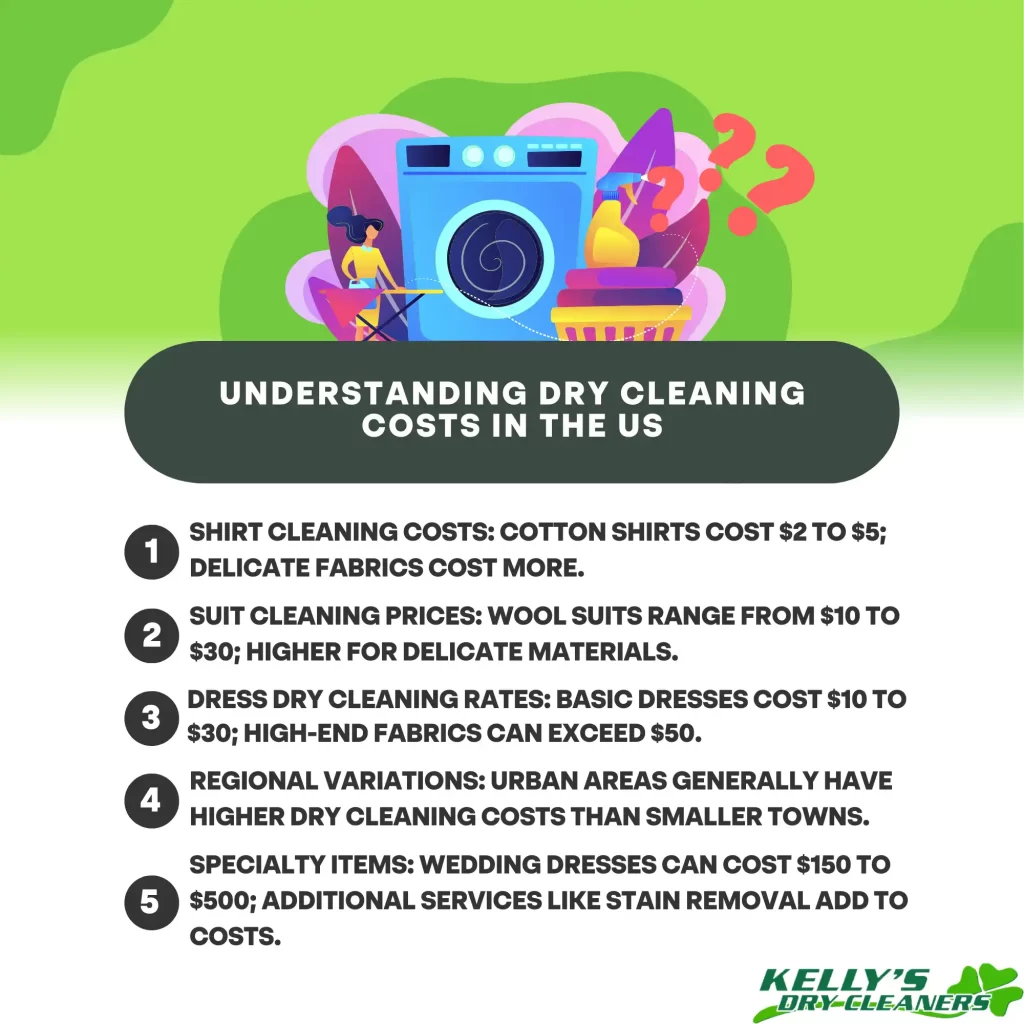Dry cleaning costs in the US can vary widely based on item type, fabric, and location. Cotton shirts typically cost $2 to $5, while wool suits range from $10 to $30. Dresses can run $10 to $50 or more, especially with high-end fabrics. Pants in metropolitan areas cost $10 to $15, but as low as $4 in smaller towns. Coat and jacket prices range from $10 to $25, and specialty items like wedding dresses can cost $150 to $500. Additional services like stain removal, pressing, and repairs add to the expense. You’ll find a deeper understanding by examining each factor in detail.

Key Takeaways
- Standard Cotton Shirts: $2 to $5, with additional costs for heavy starch or crisp ironing.
- Basic Two-Piece Wool Suits: $10 to $30, higher for delicate materials or intricate detailing.
- Basic Dress Cleaning: $10 to $30, exceeding $50 for high-end fabrics or heavily embellished dresses.
- Pants and Slacks: $4 to $15, varying by location and market conditions.
- Coats and Jackets: $10 to $25, more for high-end materials like wool or leather.
Shirt Dry Cleaning Costs
When considering shirt dry cleaning costs, you’ll find that prices can vary considerably based on factors such as fabric type, level of soiling, and additional services like ironing or starch application. Typically, cotton shirts are on the lower end of the pricing spectrum, whereas delicate fabrics like silk or linen can drive up costs due to the specialized care they require.
To address the question, ‘how much does dry cleaning cost?’, you should expect a range between $2 to $5 for standard cotton shirts in most urban areas. However, dry cleaning prices can escalate to $10 or more per shirt if intricate fabrics or significant stains are involved. In addition, if you opt for additional services such as heavy starch or crisp ironing, these can add approximately $1 to $2 per shirt.
Understanding dry cleaning prices also involves recognizing regional variations. Metropolitan areas tend to have higher costs compared to smaller towns due to operational expenses. Finally, eco-friendly or organic dry cleaning services may also command a premium, typically adding around 10-20% to the base price. Consequently, ‘how much is dry cleaning?’ often depends on a multitude of variables that can influence the final cost.
Suit Dry Cleaning Prices
Suit dry cleaning prices can fluctuate considerably, often ranging from $10 to $30 depending on the material, complexity of the garment, and any additional treatments required. For instance, a basic two-piece wool suit will typically fall on the lower end of the cost spectrum. However, if your suit is made of delicate materials like silk or has intricate detailing such as embroidery, expect the cost of dry cleaning to be higher.
Dry cleaner prices also factor in the time and labor required for pressing and finishing. A suit jacket usually demands more attention than other garments due to its structure, shoulder pads, and lining. Additionally, if your suit requires stain removal or a special finish, this will further elevate the cost.
It’s also important to take into account regional variations in dry cleaner prices. Urban areas with higher living costs often have higher dry cleaning costs as well. Some dry cleaners offer package deals or memberships that can reduce the overall cost of dry cleaning if you frequent their services regularly. Understanding these variables helps you anticipate and manage the expenses associated with maintaining your suits in top condition.
Dress Dry Cleaning Rates
Dress dry cleaning rates can vary considerably based on factors such as fabric type, embellishments, and the level of care required for proper cleaning. For instance, a simple cotton dress will generally cost less to clean than a silk or satin dress due to the delicate nature of the fabric. Similarly, dresses with intricate beadwork, sequins, or lace require specialized treatment, which can increase the overall price.
Typically, you’ll find that basic dress dry cleaning services range from $10 to $30. However, high-end fabrics or heavily embellished dresses can push costs upwards to $50 or more. The variability in price is often due to the labor-intensive processes needed for specialized fabrics and designs. Hydrocarbon or ‘eco-friendly’ cleaning methods, which are gentler on delicate fabrics but more expensive than traditional perc (perchloroethylene) cleaning, can also influence the final cost.
It’s important to evaluate the reputation and expertise of the dry cleaner as well. High-end dry cleaners with extensive experience handling luxury fabrics may charge premium rates, but they offer the assurance of quality and attention to detail. Always check if additional services, like stain removal or pressing, are included in the quoted price to avoid unexpected charges.
Pants and Slacks Costs
When considering pants and slacks dry cleaning costs, you’ll notice significant regional price variations influenced by local market conditions. Fabric type plays an essential role as delicate or specialty fabrics often incur higher charges due to the need for specialized handling. Additionally, be aware of potential fees for extra services like stain removal or pressing, which can further impact the overall expense.
Regional Price Variations
Regional disparities in dry cleaning costs for pants and slacks can greatly impact your budget, with prices varying based on metropolitan demand, local competition, and operational expenses. In high-demand urban areas like New York City and San Francisco, you might encounter prices ranging from $10 to $15 per item. These elevated costs stem from the significant overheads, including real estate and labor, that businesses face in these locations.
Conversely, in smaller cities and rural areas, dry cleaning prices are generally lower. In regions like the Midwest or the South, you may find prices between $4 to $7 per pair of pants or slacks. Here, lower operational costs and reduced competition contribute to more affordable rates.
Additionally, factors such as local economic conditions and the density of dry cleaning establishments can influence rates. For instance, in cities with a higher concentration of dry cleaners, competitive pricing can drive costs down. Customer demand patterns also play a role; areas with a higher number of professionals may see increased prices due to frequent service usage.
Understanding these regional variations allows you to budget more effectively for dry cleaning services. Regardless of whether you are in a bustling metropolis or a quieter town, being aware of local pricing trends guarantees you are not caught off guard by unexpected costs.
Fabric Type Impact
The type of fabric used in pants and slacks greatly influences dry cleaning costs, with materials like silk and linen often commanding higher prices due to their delicate nature and specialized care requirements. Silk, for instance, requires meticulous handling to avoid fabric distortion and color bleeding. Linen, while more robust, is prone to shrinkage and wrinkling, necessitating specific cleaning cycles and pressing techniques.
Wool and wool-blends are another common fabric in slacks, and though they’re more durable, they still need careful cleaning to prevent felting and maintain fabric integrity. Synthetic fibers like polyester and rayon, while generally less expensive to clean, can pose challenges if blended with other materials, which may require targeted cleaning protocols to preserve fabric quality.
When considering cotton pants, the cost tends to be on the lower end of the spectrum. However, heavily soiled or stained cotton garments might incur additional charges due to the extra effort required for stain removal. The use of advanced machinery, eco-friendly solvents, and specialized detergents further impacts the pricing structure. Understanding these nuances will help you anticipate the dry cleaning costs of your pants and slacks based on their fabric composition.
Additional Services Fees
In addition to standard cleaning, additional services like stain removal, pressing, and minor repairs can greatly impact the overall cost of dry cleaning pants and slacks. Stain removal is particularly important, as different stains require specific treatments. For instance, oil-based stains might necessitate the use of specialized solvents, which can add $5 to $10 per item.
Pressing services guarantee that your pants and slacks maintain a crisp, professional appearance. This service typically adds about $3 to $5 to the base dry cleaning cost. If you’re looking to have minor repairs done, such as replacing a button or fixing a small tear, expect to pay an additional $5 to $15, depending on the complexity of the repair.
Moreover, special treatments like waterproofing can also be requested. This service usually costs around $10 to $20 per garment. Be mindful that these additional fees accumulate quickly, potentially doubling the initial cost. Consequently, it’s advisable to discuss with your dry cleaner the necessity and cost of each additional service. Understanding these fees can help you make informed decisions and manage your dry cleaning expenses more effectively.
Coat and Jacket Prices
When examining coat and jacket prices for dry cleaning, you’ll notice significant price range variations influenced by factors such as fabric type, garment construction, and regional market rates. High-end materials like wool or leather often incur higher cleaning costs due to specialized treatment requirements. Additionally, intricate designs or added features like linings and buttons can further impact the final price.
Price Range Variations
Coat and jacket dry cleaning prices can vary considerably, often ranging from $10 to $25 depending on fabric type, garment size, and regional market rates. For instance, a simple cotton jacket might be on the lower end of the spectrum, whereas a wool coat or a down-filled jacket could cost more due to the specialized cleaning processes required. Factors such as the presence of delicate linings or embellishments can also increase costs.
Regional market rates play a significant role in price variations. Urban areas with higher operating costs typically charge more than rural locations. For example, in metropolitan areas like New York City or Los Angeles, you might find prices leaning towards the higher end, whereas smaller towns might offer more competitive rates.
Additionally, some dry cleaners employ advanced cleaning technologies such as hydrocarbon or GreenEarth solutions, which can influence pricing. These eco-friendly methods, while effective, often come with a premium. It’s crucial to reflect on whether the dry cleaner uses these advanced techniques or traditional perchloroethylene (perc) cleaning.
Understanding these variables can help you make informed decisions about where to take your coats and jackets for dry cleaning, guaranteeing you get the best value for your money without compromising on quality.
Factors Affecting Cost
Understanding the various factors that contribute to the cost of dry cleaning coats and jackets is critical for making informed choices and guaranteeing ideal care for your garments. Fabric type is one of the primary determinants; natural fibers like wool or cashmere require specialized treatment, driving up costs compared to synthetic materials. In addition, embellishments such as embroidery or sequins necessitate meticulous handling, further impacting the price.
The garment’s construction complexity also plays a role. A lined coat demands more labor-intensive processes than an unlined jacket. Moreover, stain treatment can greatly affect pricing. Persistent or complex stains, like oil or ink, often require multiple treatments or specialized solvents, increasing the overall cost.
Geographical location is another important element. Dry cleaning services in metropolitan areas tend to be pricier due to higher overhead costs, including rent and labor, compared to suburban or rural establishments. Finally, the reputation and expertise of the dry cleaner can influence prices. Premium services often charge more but offer advanced techniques and higher-quality results.
Blouse Dry Cleaning Fees
Blouse dry cleaning fees, often varying by region and fabric type, typically range from $5 to $15 per item. When considering the cost, there are several factors that directly influence the final price. Understanding these can aid you budget more effectively and choose a service that meets your needs.
- Fabric Type: Delicate fabrics like silk or chiffon usually cost more to clean due to the specialized handling and care required.
- Region: Prices can fluctuate considerably based on geographic location. Urban areas with higher living costs often have higher cleaning fees.
- Stain Treatment: If your blouse requires pre-treatment for stains, expect additional charges. Stain removal is a meticulous process involving specific solvents and techniques.
- Service Level: Premium services, such as same-day cleaning or hand-finishing, can increase the overall cost. Opting for these services guarantees a higher standard of care but at a premium price.
Skirt Cleaning Expenses
Similar to blouse dry cleaning fees, skirt cleaning expenses also vary greatly based on factors like fabric type, regional pricing differences, and additional services required. When analyzing skirt dry cleaning costs, one must consider the material composition. For instance, a silk skirt typically demands a higher rate compared to a polyester one due to its delicate nature and specialized cleaning protocols.
Regional pricing differences are also significant. In metropolitan areas, where operational costs are higher, you’ll likely encounter elevated prices. Conversely, in smaller towns, the rates may be more economical.
Additional services can further impact the overall cost. If your skirt requires stain removal, fabric conditioning, or hand-pressing, expect to pay extra fees. These services necessitate more labor-intensive processes and specialized expertise, which are reflected in the pricing.
On average, you can anticipate skirt dry cleaning prices to range between $4 to $20 per item. Nevertheless, the final cost can deviate based on the aforementioned variables. To obtain the most accurate estimate, it’s advisable to consult with your local dry cleaner and inquire about their specific charges and any potential additional fees. This guarantees transparency and helps you budget accordingly.
Specialty Item Charges
When it comes to specialty item charges, dry cleaning services often factor in unique handling requirements, intricate designs, and delicate fabrics that demand advanced care techniques. These items require specialized attention beyond standard garment cleaning, translating to higher costs. Understanding these charges can help you anticipate expenses and guarantee your garments receive the appropriate care.
Here are four common specialty items and their typical dry cleaning costs:
- Wedding Dresses – Due to their elaborate designs and delicate fabrics, cleaning a wedding dress can range from $150 to $500. This includes stain treatment, fabric preservation, and intricate detailing.
- Suits – Both men’s and women’s suits often require meticulous pressing and care, generally costing between $20 and $50 per suit.
- Leather Jackets – Cleaning leather involves special solvents and conditioners that can range from $40 to $100, depending on the jacket’s condition and type of leather.
- Curtains and Drapes – These large, often heavy items require industrial-grade cleaning equipment, with prices ranging from $10 to $30 per panel, depending on size and fabric.
Conclusion
In summary, calculating clothing care costs can be essential for keeping your closet clean. Whether it’s shirts, suits, skirts, or specialty items, understanding dry cleaning prices guarantees you’re spending smartly. Staying savvy about slacks and skirts, coats, and blouses will help you maintain meticulous maintenance without monetary mishaps. Don’t let dry cleaning expenses catch you off guard; consistent cost-consciousness and industry insight are vital for keeping your wardrobe well-maintained and wallet-friendly.



